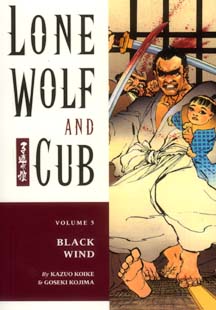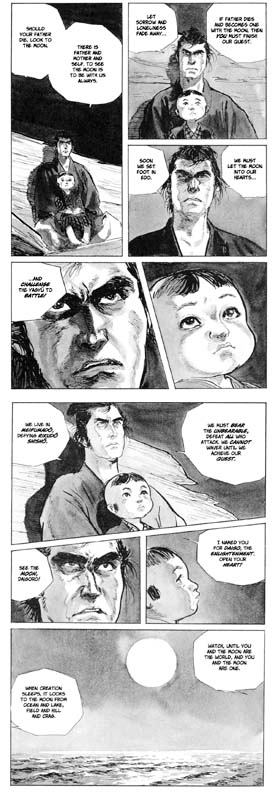

DRAWN & QUARTERED
Graphic Arts As Literature

Local Japanese samurai movie enthusiasts are familiar with the Baby Cart film series of the 1970s that depict the bloody tale of Ogami Itto, a former executioner for the 15th-century Tokugawa Shogunate framed by a villainous rival clan. The Yagyu clan ends up murdering all of Itto's family save for his infant son, Daigoro. ‘Lone Wolf’ achieves
American successThe intense Japanese comic of a
samurai assassin tries to be true
to 15th-century Japan cultureBy Gary C.W. Chun
gchun@starbulletin.comThe series, starting with "Shogun Assassin" (a k a "Sword of Vengeance" in its original, uncut version in Japan), shows Itto, vowing vengeance on the clan, wandering the countryside as a "ronin" (masterless samurai), with his young son towed in a baby cart customized with hidden spears and guns.
The films are also known by the title of "Lone Wolf and Cub," which segues to our column's topic about the successful American reprinting of the entire manga series brilliantly rendered by writer Kazuo Koike and artist Goseki Kojima. A landmark in Japanese comics, this is intense, adult material a world away from the "big eyes and speed lines" usually associated with manga.
"These are seminal comics," British creator Warren Ellis wrote for artbomb.net. "Violence in the graphic novel begins with Koike and Kojima. They invent the vocabulary here; slow motion, motion blur, speed and fury and horror. It changed the medium the way Kurosawa changed film."
Eighteen of the 28 volumes of "Lone Wolf and Cub" have been released to date, all digest-size, black-and-white serial editions, each averaging 300 pages. While the initial reaction to the small size was negative, readers have come around.
Manga and series editor-enthusiast Tim Ervin-Gore explained how they ended up with and decided to release, through independent Dark Horse Comics, the complete story of "Lone Wolf and Cub" for the first time in the United States.
Like many fans, they were dissatisfied by First Comics' (now defunct) incomplete initial run in 1987. "Rights to the title were floating around, and in a conversation with the licensing company Mega House to get rights for another Japanese title, it was mentioned that 'Lone Wolf and Cub' was available," Ervin-Gore said. "We jumped at the opportunity to get the American rights and committed to reprint the entire series in 28 volumes."
While Dark Horse's reprints have proven to be better in both reproduction and translation, the decision to reprint the pages as mirrored images, not only reversing the order of pages to read front-to-back for American readers (instead of the other way as in Japan) but flipping over the panels as well, threw purists into a tizzy. "They say that samurai would never wield their sword with the left hand," Ervin-Gore said, "but their criticism has been in the minority."
The manga attempts to be true to the culture of 15th-century Japan. "It usually takes the translator most of a month to do one volume, so it's been quite a challenge to keep a regular printing and release schedule for the series," he said.
But the attention to quality has paid off. "While the initial print run started off low, Volume 1 was reprinted almost immediately," Ervin-Gore said. Subsequent volumes also had multiple reprints, as well as increased press runs.
In comparing the manga series to its film counterpart (also written by Koike), Ervin-Gore said: "In watching the movies, I found that I was happy to have read the comic books first. The films are like a extremely shortened form of the comics, using the comics' panels like a storyboard. I was impressed with the re-enactment, although the films were more dramatic in the bloodletting."
I agree with Ervin-Gore's opinion that the longer comic-book version is more expressive and nuanced in emotion, even though the savage violence and body count is graphically illustrated. But blood spraying out of an open wound as depicted in a black-and-white comic is more artistically abstract, making it easier to distance oneself from the gore.
And events don't get easier for our two protagonists with each volume. Now, with the Yagyu clan in full pursuit of Itto and his son, "it gets worse for Itto in particular, where he'll actually feel regret and cry over some of the people he's been hired to assassinate."
All this emotional and spiritual heaviness is tempered by the occasional adventure the young Daigoro experiences away from his father. "With these particular chapters," Ervin-Gore said, "Koike helps provide a light, innocent feeling when he deals with the kid," although Daigoro is "very Bushido," as much the warrior as his father.
THE FIRST SERIES of covers for Dark Horse's "Lone Wolf and Cub" were reprints of Frank Miller's striking series for the initial First Comics run. New impressionistic covers by Bill Sienkiewicz followed, and Grendel creator Matt Wagner is producing new paintings for a future eight volumes. The artists, Miller in particular, have been influenced in turn by the series' tone and content.
"One of the things I enjoy about the series came to light to me when I took a Japanese language class to acquaint myself with the country's culture," Ervin-Gore said. "It was taught by a 50-year-old lady who knew I worked with manga, and during one conversation I brought up 'Kozure Okami,' and she was familiar with it!
"In working in American comics, I know it's hard to transcend ages and to bring in an older readership," he said. "Comparing that to Japan, the overall population always reads manga, even as they get older. So I feel 'Lone Wolf and Cub' is one of the few comics that can bridge that age gap and can appeal not only to more mature kids, but reach adults as well. If more expatriates from Japan knew about it the comic, I think they'd pick it up, too."
And you should, too.

|
Each volume of Dark Horse's "Lone Wolf and Cub" series is priced at $9.95.
Click for online
calendars and events.